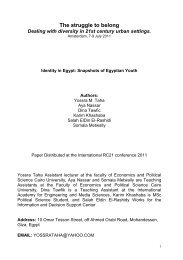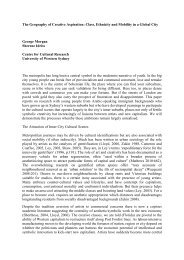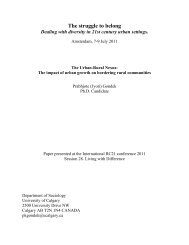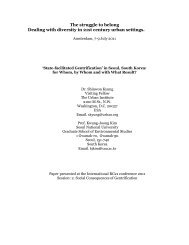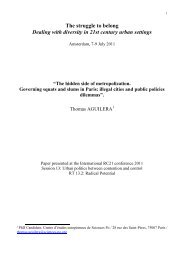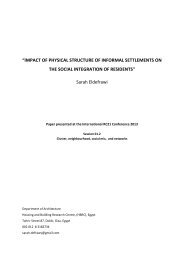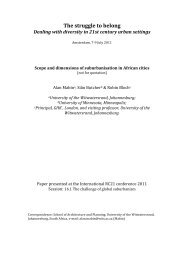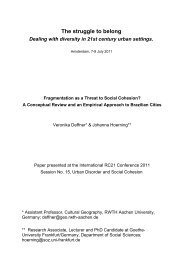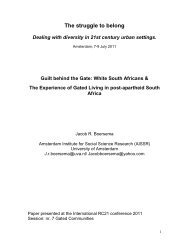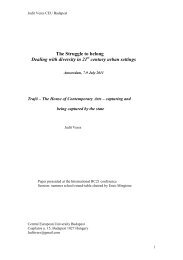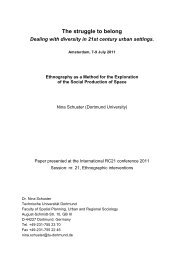Gentrification in the mill land areas of Mumbai city - RC21 ORG ...
Gentrification in the mill land areas of Mumbai city - RC21 ORG ...
Gentrification in the mill land areas of Mumbai city - RC21 ORG ...
Create successful ePaper yourself
Turn your PDF publications into a flip-book with our unique Google optimized e-Paper software.
would like to take up a case study <strong>of</strong> gentrification happen<strong>in</strong>g <strong>in</strong> <strong>the</strong> neighbourhood <strong>of</strong> <strong>the</strong><br />
<strong>mill</strong> <strong>land</strong>s <strong>in</strong> <strong>Mumbai</strong>.<br />
<strong>Gentrification</strong> <strong>in</strong> <strong>the</strong> textile <strong>mill</strong> <strong>land</strong>s <strong>of</strong> <strong>Mumbai</strong> started after <strong>the</strong> closure <strong>of</strong> <strong>the</strong> textile <strong>mill</strong>s<br />
and with <strong>the</strong> formulation <strong>of</strong> <strong>the</strong> neo liberal policies. The government and <strong>the</strong> <strong>mill</strong> owners<br />
formulated certa<strong>in</strong> policies for redevelopment <strong>in</strong> order to revive <strong>the</strong> <strong>mill</strong>s and to generate<br />
pr<strong>of</strong>it from it. But <strong>the</strong> orig<strong>in</strong>al motive beh<strong>in</strong>d <strong>the</strong> revival was never philanthropic. With<br />
certa<strong>in</strong> vested <strong>in</strong>terest <strong>in</strong> <strong>the</strong>ir m<strong>in</strong>d, <strong>the</strong> portion <strong>of</strong> <strong>the</strong> <strong>mill</strong>s which were not sick was also<br />
made to be sick ei<strong>the</strong>r by sell<strong>in</strong>g <strong>the</strong> mach<strong>in</strong>eries from <strong>the</strong> <strong>mill</strong>s or by excessive retrenchment.<br />
The <strong>mill</strong> owners looked for short term pr<strong>of</strong>it and <strong>the</strong>y siphoned <strong>of</strong>f <strong>the</strong> money to o<strong>the</strong>r<br />
commercial projects <strong>in</strong> order to make more pr<strong>of</strong>it (D’Monte, 2002; Adarkar, 2006)<br />
The <strong>mill</strong>s started clos<strong>in</strong>g one after <strong>the</strong> o<strong>the</strong>r after <strong>the</strong> great textile <strong>mill</strong> strike. The <strong>mill</strong> <strong>land</strong>s<br />
and associated chawls <strong>in</strong> <strong>the</strong> neighbourhood went <strong>in</strong>to a blighted condition. This phase was<br />
aggravated by change <strong>in</strong> occupational structure that caused to outmigration <strong>of</strong> people. As<br />
<strong>mill</strong>s went on clos<strong>in</strong>g, <strong>the</strong>re was a large scale retrenchment <strong>of</strong> <strong>the</strong> workers with m<strong>in</strong>imum<br />
compensation. Workers were forced to take retirement with meagre compensation. Those who<br />
have taken <strong>the</strong> retirement <strong>in</strong>1993 under <strong>the</strong> pressure <strong>of</strong> <strong>the</strong> <strong>mill</strong> owners and <strong>the</strong> active trade<br />
union RMMS received a compensation <strong>of</strong> merely Rs 60,000 to 70,000. But those who have<br />
managed to work <strong>in</strong> <strong>the</strong> <strong>mill</strong> till 1996 <strong>the</strong>y have received a compensation <strong>of</strong> approx 1 lakh 70<br />
thousand rupees or more accord<strong>in</strong>g to <strong>the</strong> year <strong>of</strong> service. But those who were badli workers<br />
<strong>the</strong>y did not received anyth<strong>in</strong>g.<br />
When we glance through <strong>the</strong> migration pattern <strong>of</strong> <strong>the</strong> area, we realize that, dur<strong>in</strong>g this period<br />
many have returned back to <strong>the</strong>ir villages. Out <strong>of</strong> <strong>the</strong>m some returned after a long period <strong>of</strong><br />
time. It has been noted <strong>in</strong> <strong>the</strong> census that <strong>in</strong> <strong>the</strong> G/S ward at Ch<strong>in</strong>chpokli Section <strong>the</strong><br />
population <strong>in</strong>creased till 1981 with a positive decadal growth rate <strong>of</strong> 4.49 percent <strong>in</strong> 1961-71<br />
and 17.05 percent <strong>in</strong> 1971-81whereas s<strong>in</strong>ce <strong>the</strong>n it started decreas<strong>in</strong>g cont<strong>in</strong>uously with a<br />
negative decadal growth rate <strong>of</strong> -5.98percent <strong>in</strong> 1981-91 and -4.02 percent <strong>in</strong> 1991-2001.<br />
Consider<strong>in</strong>g <strong>the</strong> male population, it has <strong>in</strong>creased till 1981 with a positive decadal growth rate<br />
<strong>of</strong> 2.24 percent <strong>in</strong> 1961-71 and 14.99 percent <strong>in</strong> 1971-81. But as <strong>the</strong> total population<br />
decreased <strong>the</strong> male population simultaneously decreased with a negative decadal growth rate<br />
<strong>of</strong> -10.65percent <strong>in</strong> 1981-91 and -6.18 percent <strong>in</strong> 1991-2001.The female population on <strong>the</strong><br />
o<strong>the</strong>r hand rose steadily till 1991 with a positive decadal growth rate <strong>of</strong> 9.07 percent <strong>in</strong> 1961-<br />
71 and 21.10 percent <strong>in</strong> 1971-1981.In 1981-91 though <strong>the</strong> female population <strong>in</strong>creased but <strong>the</strong>




